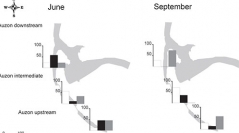

 Cryptogamie, Algologie
36 (3) - Pages 323-355
Cryptogamie, Algologie
36 (3) - Pages 323-355Currently, a consensus has been reached to protect and restore cut-off meanders. Therefore, it is important to understand how these wetlands function. To our knowledge, the spatial and temporal distribution of both benthic diatoms and macroinvertebrates, associated with macrophytes communities, linked to the geomorphology, has not been studied extensively. In the upstream and intermediate zones, the low water temperature and the high conductivity revealed a connection with the groundwater. Moreover, the geomorphological riffle characterizing the intermediate zone created the same downwelling and upwelling processes as in running water, with a groundwater/hyporheic/surface water ecotone and produced physico-chemical differences between the upstream and the downstream zones and thereby modify the diatom, macroinvertebrate and macrophyte distribution. Downstream, water input from the main channel of the Allier River allowed the development of taxa observed in the River. All these hydrological connections and the sedimentation modified the physical, chemical and geomorphological characteristics, thereby, creating a gradient of water quality, influencing the distribution of the biotic communities.